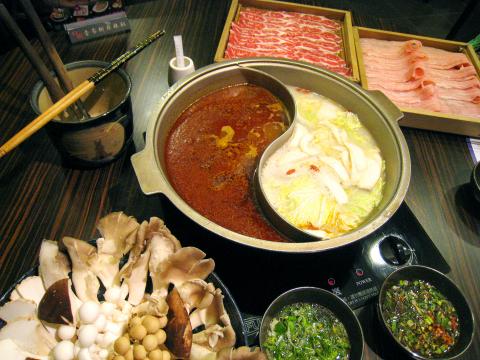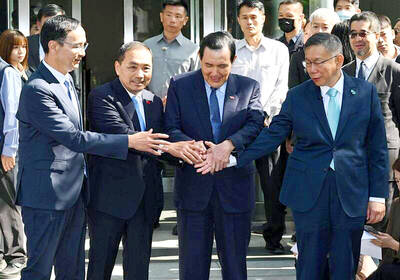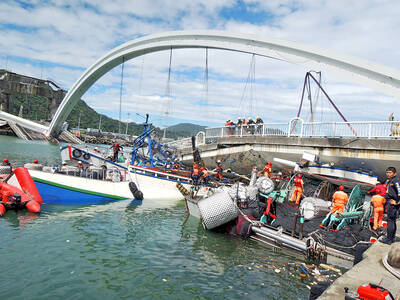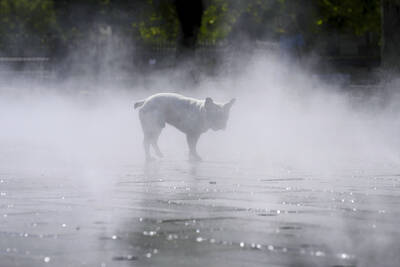Spicy hot pot (麻辣鍋) is a perennial winter favorite, and Taipei is thick with inexpensive all-you-can-eat hot pot joints and slick, pricey establishments boasting select ingredients and finely concocted broths. 108 Hot Pot (壹零捌麻辣鍋) aims for the latter category, but isn’t a complete success. While the food is delicious, the bill can quickly mount up. And when it comes to service, 108 lags behind other restaurants in a similar price range.
Three minutes on foot from the intersection of Daan Road (大安路) and Zhongxiao East Road (忠孝東路) in Taipei, the two-floor establishment is hard to miss. A purple neon sign outside the entrance screams for attention. Thankfully, the interior is quieter. Tables can seat a party of two up to a group of 12, and for extra privacy the restaurant has 10 roomy booths, which require reservations.
The restaurant is lauded for its three varieties of hot pot broth. According to its Web site, the spicy version is infused with more than 30 herbs and spices. The lustrous red stock’s flavor is rich and smooth, and doesn’t pack much of a chili punch. For more of a kick, order the “medium hot” (中辣) or “very hot” (大辣).

Photo: Ho Yi, Taipei Times
For a sweeter stock, one of the other options is a chicken-based white broth, with hints of ginger and goji berry. An equally delectable tomato-based broth is also available. Diners have to pay an extra NT$120 for a pot that has half chili broth and half non-spicy broth (鴛鴦鍋).
The top-of-the-range food served at 108 is exemplified by the fine quality of the meat items such as prime beef (招牌牛小排, NT$360), Matsusaka pork (雪花松阪豬, NT$320) and mutton (極品小羔羊, NT$290). Seafood options include drunken shrimp (生猛醉翁蝦, NT$290), South African abalone (南非活鮑魚, NT$180 each) and clams (生鮮活蛤蠣, NT$180). The aquariums next to the entrance on the first floor assure diners that their food arrives on the table alive and kicking (except the shrimp, which are numbed in a bowl of Shaohsing rice wine (紹興酒) before meeting their fate in the boiling pot).
The restaurant’s respectable selection of vegetables includes cabbage (高麗菜苗, NT$90), Japanese mountain yam (日本山藥, NT$120), edible chrysanthemum (茼蒿, or tong hao, at NT$90), bamboo fungus (竹笙, NT$120), black jelly fungus (黑木耳, NT$80), golden needle mushrooms (金針菇, NT$80) and king oyster mushroom (杏鮑菇, NT$100).
But what really impresses are the handmade meatballs, such as shrimp balls in loofah (香煎角瓜球, NT$140) and pork in green pepper (翡翠椒鑲肉, NT$140). The finely chopped shrimp wrapped in juicy sponge cucumber leaves a lasting tickle of savoriness on the taste buds. The green pepper rolls are equally delicious. Try cooking the roll in the chili broth and then dipping it in the vinegar sauce to fine tune the spiciness and create multiple layers of flavor.
The big letdown, though, is the waitstaff. During a recent visit on a cold, rainy Sunday evening, the service was unforgivably sluggish given that the restaurant was only half full. To top it off, we were served meat that we hadn’t ordered.

Has the Taiwan People’s Party (TPP) changed under the leadership of Huang Kuo-chang (黃國昌)? In tone and messaging, it obviously has, but this is largely driven by events over the past year. How much is surface noise, and how much is substance? How differently party founder Ko Wen-je (柯文哲) would have handled these events is impossible to determine because the biggest event was Ko’s own arrest on multiple corruption charges and being jailed incommunicado. To understand the similarities and differences that may be evolving in the Huang era, we must first understand Ko’s TPP. ELECTORAL STRATEGY The party’s strategy under Ko was

Before the recall election drowned out other news, CNN last month became the latest in a long line of media organs to report on abuses of migrant workers in Taiwan’s fishing fleet. After a brief flare of interest, the news media moved on. The migrant worker issues, however, did not. CNN’s stinging title, “Taiwan is held up as a bastion of liberal values. But migrant workers report abuse, injury and death in its fishing industry,” was widely quoted, including by the Fisheries Agency in its response. It obviously hurt. The Fisheries Agency was not slow to convey a classic government

It was on his honeymoon in Kuala Lumpur, looking out of his hotel window at the silvery points of the world’s tallest twin skyscrapers, that Frank decided it was time to become taller. He had recently confessed to his new wife how much his height had bothered him since he was a teenager. As a man dedicated to self-improvement, Frank wanted to take action. He picked up the phone, called a clinic in Turkey that specializes in leg lengthening surgery — and made a booking. “I had a lot of second thoughts — at the end of the day, someone’s going

It turns out many Americans aren’t great at identifying which personal decisions contribute most to climate change. A study recently published by the National Academy of Sciences found that when asked to rank actions, such as swapping a car that uses gasoline for an electric one, carpooling or reducing food waste, participants weren’t very accurate when assessing how much those actions contributed to climate change, which is caused mostly by the release of greenhouse gases that happen when fuels like gasoline, oil and coal are burned. “People over-assign impact to actually pretty low-impact actions such as recycling, and underestimate the actual carbon